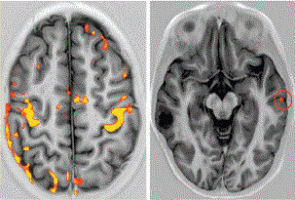
Researchers at University of California San Diego School of Medicine have demonstrated that distinct types of glioblastoma, the most common form of brain cancer in adults, tend to develop in different regions of the brain.
This finding provides an explanation for how the same cancer-causing mutation can give rise to different types of brain malignancies.
Results of the study were published in Oncotarget.
"It is now well-documented that cancers that look the same under the microscope actually contain different genetic changes, or mutations, and respond differently to therapy," said Clark Chen, MD, PhD, senior author and vice-chair of research and academic development in the Division of Neurosurgery at UC San Diego School of Medicine. "What remains unclear is how the exact, same mutation can give rise to different subtypes of tumour."
To study this mystery, Chen's team developed a new computational method to define where different glioblastoma subtypes develop in the brain.
Using clinical images derived from 217 brain tumour patients, Chen's team discovered that proneural and neural glioblastoma subtypes tend to occur closer to the center of the brain in a region called the subventricular zone (SVZ).
In contrast, mesenchymal and classical glioblastoma subtypes tend to develop farther from this region.
The subventricular zone is a unique region of the brain where neural stem cells, which ultimately give rise to all cell types in the brain, reside.
During brain development, these stem cells migrate outward from the center region.
During this process, the stem cells transform into the dozen or so different cell types that compose the human brain.
"Our study suggests that if a cancer-causing mutation occurs in the neural stem cell population in the SVZ, it gives rise to the proneural or the neural glioblastoma subtype.
On the other hand, if the same mutation occurs in a different cell population located farther away from the SVZ, it will give rise to other subtypes," said Chen.
Through a mouse model of glioblastoma developed by Lionel Chow, MD, PhD, a pediatric hematologist-oncologist at Cincinnati Children's Hospital, Chen's team was able to confirm this hypothesis.
In Chow's model, all glioblastomas arise as a result of the same mutations.
Nevertheless, the brain tumours that form closer to the SVZ tend to be proneural or neural subtypes, while tumours form farther from the SVZ tend to be classical or mesenchymal subtypes.
"Because glioblastoma subtypes respond differently to distinct therapies, subtype discrimination will be increasingly important," said Bob Carter, MD, PhD, chair of neurosurgery at UC San Diego Health. "Refinement of this non-invasive method for determining glioblastoma subtypes may achieve the goal of personalising glioblastoma therapy without subjecting our patients to surgery."
We are an independent charity and are not backed by a large company or society. We raise every penny ourselves to improve the standards of cancer care through education. You can help us continue our work to address inequalities in cancer care by making a donation.
Any donation, however small, contributes directly towards the costs of creating and sharing free oncology education.
Together we can get better outcomes for patients by tackling global inequalities in access to the results of cancer research.
Thank you for your support.